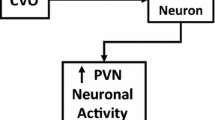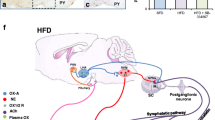Abstract
Neuropeptide Y (NPY), a metabolism-related cardiovascular factor, plays a crucial role in blood pressure (BP) regulation via peripheral and central pathways. The expression of NPY receptors (Y1R/Y2R) specific to baroreflex afferents impacts on the sexually dimorphic neural control of circulation. This study was designed to investigate the expression profiles of NPY receptors in the nodose ganglion (NG) and nucleus tractus solitary (NTS) under hypertensive conditions. To this end, rats with hypertension induced by NG-nitro-L-arginine methylester (L-NAME) or high fructose drinking (HFD), and spontaneously hypertensive rats (SHRs) were used to explore the effects/mechanisms of NPY on BP using functional, molecular, and electrophysiological approaches. The data showed that BP was elevated along with baroreceptor sensitivity dysfunction in model rats; Y1R was up- or down-regulated in the NG or NTS of male and female HFD/L-NAME groups, while Y2R was only down-regulated in the HFD groups as well as in the NG of the male L-NAME group. In SHRs, Y1R and Y2R were both down-regulated in the NTS, and not in the NG. In addition to NPY-mediated energy homeostasis, leptin-melanocortin activation may be essential for metabolic disturbance-related hypertension. We found that leptin and α-melanocyte stimulating hormone (α-MSH) receptors were aberrantly down-regulated in HFD rats. In addition, α-MSH concentrations were reduced and NPY concentrations were elevated in the serum and NTS at 60 and 90 min after acute leptin infusion. Electrophysiological recordings showed that the decay time-constant and area under the curve of excitatory post-synaptic currents were decreased by Y1R activation in A-types, whereas, both were increased by Y2R activation in Ah- or C-types. These results demonstrate that sex- and afferent-specific NPY receptor expression in the baroreflex afferent pathway is likely to be a novel target for the clinical management of metabolism-related and essential hypertension.







Similar content being viewed by others
References
Tatemoto K, Carlquist M, Mutt V. Neuropeptide Y–a novel brain peptide with structural similarities to peptide YY and pancreatic polypeptide. Nature 1982, 296: 659–660.
Lang UE, Beglinger C, Schweinfurth N, Walter M, Borgwardt S. Nutritional aspects of depression. Cell Physiol Biochem 2015, 37: 1029–1043.
Bouret SG. Development of Hypothalamic Circuits That Control Food Intake and Energy Balance. In: Harris RBS (Ed.). Appetite and Food Intake: Central Control. Boca Raton (FL): CRC Press/Taylor & Francis, 2017: 135–154.
Loh K, Herzog H, Shi YC. Regulation of energy homeostasis by the NPY system. Trends Endocrinol Metab 2015, 26: 125–135.
Jacques D, Abdel-Samad D. Neuropeptide Y (NPY) and NPY receptors in the cardiovascular system: implication in the regulation of intracellular calcium. Can J Physiol Pharmacol 2007, 85: 43–53.
Kennedy B, Shen GH, Ziegler MG. Neuropeptide Y-mediated pressor responses following high-frequency stimulation of the rat sympathetic nervous system. J Pharmacol Exp Ther 1997, 281: 291–296.
Cheng PW, Wu AT, Lu PJ, Yang YC, Ho WY, Lin HC, et al. Central hypotensive effects of neuropeptide Y are modulated by endothelial nitric oxide synthase after activation by ribosomal protein S6 kinase. Br J Pharmacol 2012, 167: 1148–1160.
Wahlestedt C, Yanaihara N, Hakanson R. Evidence for different pre-and post-junctional receptors for neuropeptide Y and related peptides. Regul Pept 1986, 13: 307–318.
Liu Y, Wu D, Qu MY, He JL, Yuan M, Zhao M, et al. Neuropeptide Y-mediated sex- and afferent-specific neurotransmissions contribute to sexual dimorphism of baroreflex afferent function. Oncotarget 2016, 7: 66135–66148.
Barraco RA, Ergene E, Dunbar JC, Ganduri YL, Anderson GF. Y2 receptors for neuropeptide Y in the nucleus of the solitary tract mediate depressor responses. Peptides 1991, 12: 691–698.
Mankin LA. Update in hypertension therapy. Med Clin North Am 2016, 100: 665–693.
Tu H, Zhang D, Li YL. Cellular and molecular mechanisms underlying arterial baroreceptor remodeling in cardiovascular diseases and diabetes. Neurosci Bull 2019, 35: 98–112.
Potje SR, Munhoz FC, Perassa LA, Graton ME, Pereira AA, Nakamune AC, et al. Mechanisms underlying the hypotensive and vasodilator effects of Ru(terpy)(bdq)NO](3 +), a nitric oxide donor, differ between normotensive and spontaneously hypertensive rats. Eur J Pharmacol 2014, 741: 222–229.
Yi M, Li H, Wu Z, Yan J, Liu Q, Ou C, et al. A promising therapeutic target for metabolic diseases: neuropeptide Y receptors in humans. Cell Physiol Biochem 2018, 45: 88–107.
Zemancikova A, Torok J. Cardiovascular effects of high-fructose intake in rats with nitric oxide deficiency. Interdiscip Toxicol 2014, 7: 159–164.
Cyr NE, Toorie AM, Steger JS, Sochat MM, Hyner S, Perello M, et al. Mechanisms by which the orexigen NPY regulates anorexigenic alpha-MSH and TRH. Am J Physiol Endocrinol Metab 2013, 304: E640–650.
do Carmo JM, da Silva AA, Freeman JN, Wang Z, Moak SP, Hankins MW, et al. Neuronal suppressor of cytokine signaling 3: Role in modulating chronic metabolic and cardiovascular effects of leptin. Hypertension 2018, 71: 1248–1257.
Andresen MC, Kunze DL. Nucleus tractus solitarius–gateway to neural circulatory control. Annu Rev Physiol 1994, 56: 93–116.
Browning KN. Excitability of nodose ganglion cells and their role in vago-vagal reflex control of gastrointestinal function. Curr Opin Pharmacol 2003, 3: 613–617.
Kawai Y, Senba E. Organization of excitatory and inhibitory local networks in the caudal nucleus of tractus solitarius of rats revealed in in vitro slice preparation. J Comp Neurol 1996, 373: 309–321.
Lachamp P, Balland B, Tell F, Crest M, Kessler JP. Synaptic localization of the glutamate receptor subunit GluR2 in the rat nucleus tractus solitarii. Eur J Neurosci 2003, 17: 892–896.
Travagli RA, Hermann GE, Browning KN, Rogers RC. Brainstem circuits regulating gastric function. Annu Rev Physiol 2006, 68: 279–305.
Jin YH, Bailey TW, Li BY, Schild JH, Andresen MC. Purinergic and vanilloid receptor activation releases glutamate from separate cranial afferent terminals in nucleus tractus solitarius. J Neurosci 2004, 24: 4709–4717.
Baltazi M, Katsiki N, Savopoulos C, Iliadis F, Koliakos G, Hatzitolios AI. Plasma neuropeptide Y (NPY) and alpha-melanocyte stimulating hormone (a-MSH) levels in patients with or without hypertension and/or obesity: a pilot study. Am J Cardiovasc Dis 2011, 1: 48–59.
Mountjoy KG, Mortrud MT, Low MJ, Simerly RB, Cone RD. Localization of the melanocortin-4 receptor (MC4-R) in neuroendocrine and autonomic control circuits in the brain. Mol Endocrinol 1994, 8: 1298–1308.
Matsumura K, Tsuchihashi T, Fujii K, Iida M. Neural regulation of blood pressure by leptin and the related peptides. Regul Pept 2003, 114: 79–86.
Puzserova A, Bernatova I. Blood pressure regulation in stress: focus on nitric oxide-dependent mechanisms. Physiol Res 2016, 65: S309–S342.
Lim K, Barzel B, Burke SL, Armitage JA, Head GA. Origin of aberrant blood pressure and sympathetic regulation in diet-induced obesity. Hypertension 2016, 68: 491–500.
Barzel B, Lim K, Davern PJ, Burke SL, Armitage JA, Head GA. Central proopiomelanocortin but not neuropeptide Y mediates sympathoexcitation and hypertension in fat fed conscious rabbits. J Hypertens 2016, 34: 464–473; discussion 473.
Krukoff TL, MacTavish D, Jhamandas JH. Effects of restraint stress and spontaneous hypertension on neuropeptide Y neurones in the brainstem and arcuate nucleus. J Neuroendocrinol 1999, 11: 715–723.
Guo XW, Wang XL, Gao ZL. Effect of neuropeptide Y and neurotensin on diurnal rhythm of blood pressure and target organ damage for essential hypertension. Zhonghua Xin Xue Guan Bing Za Zhi 2005, 33: 1006–1009.
He JL, Zhao M, Xia JJ, Guan J, Liu Y, Wang LQ, et al. FGF21 ameliorates the neurocontrol of blood pressure in the high fructose-drinking rats. Sci Rep 2016, 6: 29582.
Li BY, Glazebrook P, Kunze DL, Schild JH. KCa1.1 channel contributes to cell excitability in unmyelinated but not myelinated rat vagal afferents. Am J Physiol Cell Physiol 2011, 300: C1393–1403.
Geiger JR, Jonas P. Dynamic control of presynaptic Ca(2 +) inflow by fast-inactivating K(+) channels in hippocampal mossy fiber boutons. Neuron 2000, 28: 927–939.
Sabatini BL, Regehr WG. Control of neurotransmitter release by presynaptic waveform at the granule cell to Purkinje cell synapse. J Neurosci 1997, 17: 3425–3435.
Mendelowitz D, Kunze DL. Characterization of calcium currents in aortic baroreceptor neurons. J Neurophysiol 1992, 68: 509–517.
Mendelowitz D, Reynolds PJ, Andresen MC. Heterogeneous functional expression of calcium channels at sensory and synaptic regions in nodose neurons. J Neurophysiol 1995, 73: 872–875.
Blakemore LJ, Levenson CW, Trombley PQ. Neuropeptide Y modulates excitatory synaptic transmission in the olfactory bulb. Neuroscience 2006, 138: 663–674.
Harper AA. Similarities between some properties of the soma and sensory receptors of primary afferent neurones. Exp Physiol 1991, 76: 369–377.
Shih CD, Chan JY, Chan SH. Tonic suppression of baroreceptor reflex response by endogenous neuropeptide Y at the nucleus tractus solitarius of the rat. Neurosci Lett 1992, 148: 169–172.
Matsumura K, Tsuchihashi T, Abe I, Iida M. Central alpha-melanocyte-stimulating hormone acts at melanocortin-4 receptor to activate sympathetic nervous system in conscious rabbits. Brain Res 2002, 948: 145–148.
Rahmouni K, Correia ML, Haynes WG, Mark AL. Obesity-associated hypertension: new insights into mechanisms. Hypertension 2005, 45: 9–14.
Lembo G, Vecchione C, Fratta L, Marino G, Trimarco V, d’Amati G, et al. Leptin induces direct vasodilation through distinct endothelial mechanisms. Diabetes 2000, 49: 293–297.
Acknowledgements
This work was supported by grants from the National Natural Science Foundation of China (31171122, 81573431, 81773731, 81971326, and 8190130222).
Author information
Authors and Affiliations
Corresponding authors
Ethics declarations
Conflict of interest
The authors declare that they have no conflict of interest.
Electronic supplementary material
Below is the link to the electronic supplementary material.
Rights and permissions
About this article
Cite this article
Liu, Y., Zhao, SY., Feng, Y. et al. Contribution of Baroreflex Afferent Pathway to NPY-Mediated Regulation of Blood Pressure in Rats. Neurosci. Bull. 36, 396–406 (2020). https://doi.org/10.1007/s12264-019-00438-w
Received:
Accepted:
Published:
Issue Date:
DOI: https://doi.org/10.1007/s12264-019-00438-w




